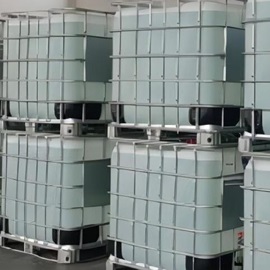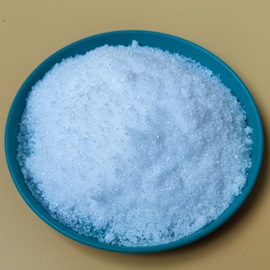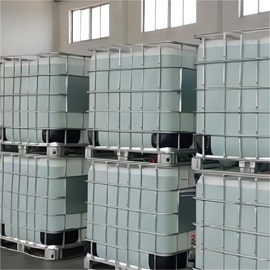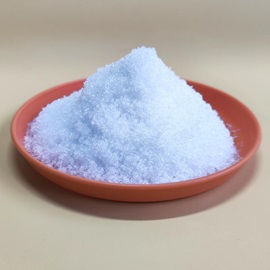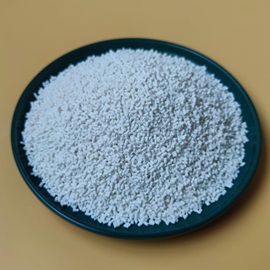Phosphorus chemicals
Potassium phosphite|CAS13492-26-7
- CAS: 13492-26-7
- MF: K2HPO3
- Min Order Quantity: 1Kg
The mechanism of action of potassium phosphite is mainly a series of biochemical reactions of +3-valent phosphorus in crops, soil and other environments. The specific mechanism of action for different conditions is very complex. The main function of potassium phosphite in agriculture is fungicide, which has been proved to be very effective through a large number of use cases. Different crops are used in different growing periods with different dosages. Its solubility is very good, and it can be soluble with most trace elements under the regulation of additives, etc. Its safety is also good.
Ⅰ, the mechanism of fungicide and disease resistance
The +3-valent phosphorus and +5-valent phosphorus have completely different action mechanisms. The +3-valent phosphorus has a good inhibitory effect on fungal diseases, inducing the crop to produce continuous immunity to pathogenic fungi and viruses. Meanwhile, +3-valent phosphorus can be bi-directionally transported through xylem and phloem, and is absorbed faster than phosphorus in the phosphate state (+5-valent), which has a very good effect on promoting roots and flowers, and increasing the content of soluble cellular matter. Potassium phosphite is involved in the plant's defense response to pathogens, transmitting disease and trauma signals to other parts of the plant causing systemic acquired resistance. When the pathogen invades, potassium phosphite induces the production of lignin in seedling cells, which increases the thickness of the cell wall, making the cell wall hard and firm, confining the pathogen to the cell wall, individual cells, or localized tissues, and thus deterring its further invasion and expansion. The +3-valent HPO3 root is an acquired system-induced resistance to disease, a type of generalized biological control. It can be absorbed by plant leaves and roots and transported to the plant body, exerting its direct bactericidal function, and at the same time initiating the disease-resistant defense system, which will stimulate the plant to produce phytodefensins and thus produce disease resistance when the pathogen invades the plant.
Ⅱ, Basic Parameters
English name: Potassium phosphite
Formula:K2HPO3
Molecular weight: 158
CAS No.: 13492-26-7
Effective content≥50%&98
Chloride Cl≤0.1%
Fe≤0.005%
Water insoluble matter≤0.5%
Ⅲ, Product Characteristics
1, Promote the growth of crop roots, developed and strong root system to improve crop absorption of water and fertilizer capacity, promote fruit color change, increase sugar level. It is not easy to be fixed in the soil, and at the same time releases iron, zinc, calcium and other elements solidified in the soil, which is easy to be absorbed and has a high absorption and utilization rate.
2, Excellent water solubility
Potassium phosphite has very high purity, good water solubility, and can reach 150/100g water at room temperature.
3,Wide application effect
Potassium phosphite for the dew fungus disease, dew disease, mildew caused by oomycetes on the prevention and control of fungal hazards have been affirmed, a combination of many researchers test found that potassium phosphite on flowers of gerbera chrysanthemums, lilies, lilies, orchids, orchids, tiger lilies, orchids, fruit trees of citrus, citrus, papaya, avocado seedlings, the old flower disease, grape dew fungus disease, lychee fruit disease, vegetables of chili peppers, bell peppers, tomatoes and potato, late blight, lettuce and potatoes, and lettuce, fruit and potatoes, fruit and vegetables. Late blight, lettuce and cruciferous fungal disease and goldenseal seedling rot disease, etc. are quite effective in preventing and controlling.
4、Green environmental protection
Eventually degraded to orthophosphate, supplementing phosphorus and potassium fertilizer to crops, which is a completely harmless and non-residual green environmental protection product.
5、It has the ability of sterilization, bacterial inhibition, enhancement of disease resistance and immunity.
6, belongs to water-soluble high phosphorus and high potassium fertilizer, with a variety of chelated trace elements, leaf spray, sprinkling, drip irrigation absorption fast, can quickly supplement phosphorus and potassium fertilizer, with ultra-high absorption efficiency.
7, no drug resistance.
It is a fungicide and a high potassium foliar fertilizer. It is a kind of phosphorus and potassium fertilizer with 3+phosphorus, and it is a kind of endosorbent fungicide, which will not produce resistance by repeated use.
8, Good compatibility
It can be mixed and compounded with most fertilizers, and can be mixed with as many trace elements fertilizers under the adjustment of appropriate additives. It is not easy to antagonize with trace elements, PH value is slightly acidic, it can be mixed with most pesticides, copper preparations and fertilizers, and it will not produce precipitation and drug damage, and the mixability is especially good.
9, Promote the old maturity of new shoots and the greening of young fruits. Repeated use will not produce resistance, reduce the number of times the drug is used, reduce the cost of medication and labor costs, low cost.
10, effectively control apical dominance, avoid excessive plant nutrient growth, regulate the closure of plant stomata. Promote flower bud differentiation and photosynthesis. Make the crop flower buds full, flowers, flowers and strong, fruiting rate and quality significantly improved. Root regulation promotes fruit expansion and coloring, prolongs the freshness period of fruit and makes its color better.
IV, Usage
A, Irrigation method
1, Crops planted in organic substrate (e.g. roses, potted plants): apply potassium phosphite once a week at a dosage of 10 liters/ha during the whole growing period, especially during the adversity period.
2, Crops in general: 1 weekly application at a rate of 6-10 liters/ha throughout the growing period, especially during periods of adversity.
3, Vegetable crops grown in rockwool (soilless vegetables): 2 applications in total, one immediately after planting and the second one at the beginning of fruit set, at a rate of 3-5 liters/ha per 1,000 liters of water for irrigation.
4, Strawberry: 4 applications, from planting to the first fruiting period, with a dosage of 8-10 liters.
5, Soil-cultivated flowers (e.g. chrysanthemums): a total of 2-3 applications, once a week from planting, at a rate of 10 liters of potassium phosphite B,Spraying method
1, Strawberry: spray 3-4 times, from the early flowering to the first fruit set, at a dosage of 3 liters/ha; for autumn spraying, dilute the 50% solution 1000 times with water, and the dosage after dilution is 12-15 liters/ha.
2, Grapes: spray 3-4 times, from the first flowering to the bunches, once a week with a dosage of 3 liters/ha.
3, Citrus fruit trees: spray 3 times, in spring, early summer and fall, each time the dosage is 1.5-2.0 L/ha.
4, Cucumber: sprayed 4-5 times, starting with 5 liters/ha after planting and 3 liters/ha once every 2 weeks.
5, Potato (potato): spray 3-4 times, starting from tuber growth, use 3-4 liters/ha every 10 days.
6, tomato: spray a few times before fruit set at a rate of 3 liters/ha.
7, Fruit trees: spray 2-3 times, at intervals of 7-10 days from flowering to the beginning of fruit set, at a dosage of 2-2.5 liters/ha, i.e. 130-170 ml of 50% solution per acre. Special advice: when the buds are particularly weak and the environment is unfavorable, spray a solution of potassium phosphite followed by ordinary foliar fertilizers.
Hectare.
C, Method of impregnation
Bare-root seedlings of crops, e.g. strawberries, can be impregnated with potassium phosphite solution before planting, so as to promote the initial growth of the crop, which is the most critical growing period of the crop. Crops should be macerated for 15-20 minutes so that the solution reaches the heart of the crop's leaves. Dilution to a 0.5% solution is recommended for use.
Can be used all year round and can be used in combination with boiled calcium, zinc, boron, nitrogen and copper preparations. It can be used in the spring and young fruit stage to accelerate the ripening of the new shoots and the greening of the young fruits, as well as to prevent the occurrence of ulcers.
Precautions
1, Store potassium phosphite in ventilated dry place, out of reach of children and avoid contact with livestock. Avoid contact with oxidizing agents.
2, do not mix with surfactants and other additives, avoid mixing with pesticide liquid and alkaline pesticides, if you need to use, please go to a small amount of test mixing, no reaction and then a large number of mixing, specific mixing methods, please consult the local agricultural technicians.
3, spraying should not be carried out in direct sunlight, preferably before 10:00 am or after 4:00 pm.
4, Do not use this product during crop dormancy, high temperature and high humidity stress period, avoid using it during extreme drought, heavy rain or frost.
V, efficacy
Beans (red beans, peas, etc.): promote fruit, increase the number of pods, improve quality, improve disease resistance.
Strawberry: increase sugar level, promote color change, promote flower bud differentiation, root rot, gray mold.
Root vegetables (garlic, onion, ginger, etc.): fruit expansion, promote root growth, improve disease resistance to downy mildew, gray mold.
Potato: promote fruit expansion, improve resistance to late blight, thick green leaves.
Leafy vegetables (spinach, lettuce, cabbage, bok choy, etc.): improve quality, improve disease resistance, reduce undigested nitrogen, promote nitrogen fertilizer absorption.
Fruit trees (citrus): promotes flower bud differentiation, fruiting, homogenization of flower buds and coloring.
Tomato: promote coloring, potassium phosphite to improve disease tolerance of late blight and gray mold.
Flower (chrysanthemum): strengthen the stem and leaves, enrich the flower buds.
Fruit trees (apple, pear, cherry, etc.): promote flower bud differentiation, color change and sugar accumulation, improve disease resistance.
Grapes: increase sugar level to promote color change, promote flower bud differentiation, reduce the occurrence of downy mildew and powdery mildew.
Fruits and vegetables, leafy vegetables: preventing and controlling the growth, strengthening the seedling, promoting photosynthesis, and improving the disease resistance.
Melon (cucumber, melon, watermelon, etc.): promote flower buds, promote fruit expansion, increase sugar level, improve resistance to downy mildew and powdery mildew.
Pepper: improve quality, improve disease resistance, reduce undigested nitrogen.
VI, Safety
Strictly according to different crops to specify the scientific dosage of use, and eliminate the overuse of potassium phosphite. Overuse will lead to serious problems. It can be compounded with chelated calcium, zinc, boron, nitrogen, copper preparations, humates, alginate, vitamins, fulvic acid, chitosan and various EDTA chelated trace elements. No precipitation, no reaction, stable solution system is the basic requirement.
The mechanism of potassium phosphite in different crops has not been fully researched, and the use of potassium phosphite in different crops, different regions and different environments is also in the exploratory stage. How to compound or mix potassium phosphite with other fertilizers to produce the effect that 1+1 is greater than N is also a key research topic.
News
Contact Us
Contact: HXOSC
Phone: +86-512-36622455 +86-13358057724(WhatsApp)
Tel: +86-512-36622455+86-13358057724
E-mail: Hxo@hxochem.com Support@hxochem.com logistic@hxochem.com
Add: No. 1377, Fuchunjiang Road, Kunshan Development Zone, Jiangsu Province, China
